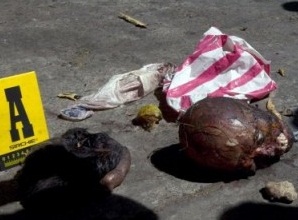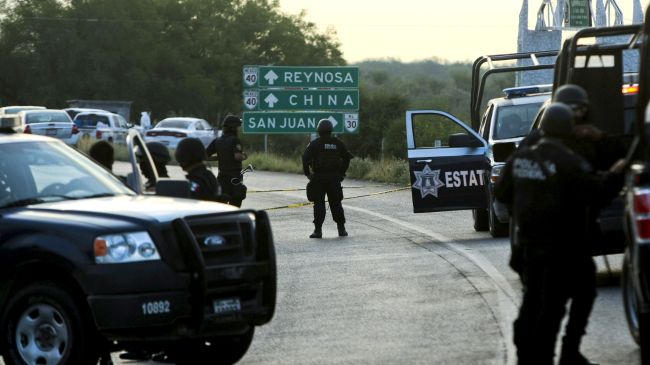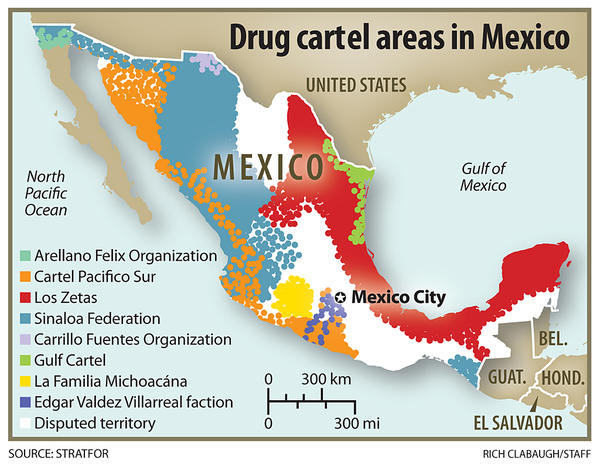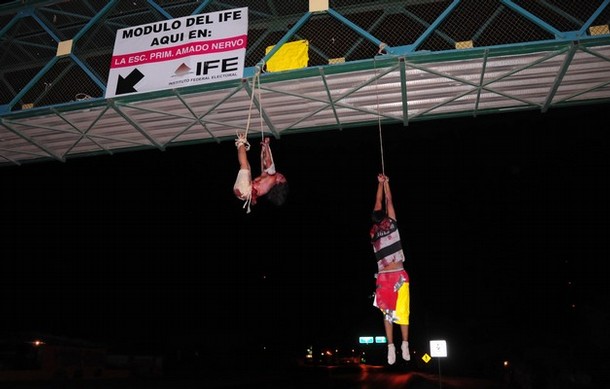The Biopolitics of Mexican Drug Cartels
While I’ve written about US-Mexican border politics before, I even did a Masters thesis on border politics, the state of affairs today in Northern Mexico is rapidly spiraling out of control. As an example, this picture from a recent ABC article in particular really struck me–an image of silver and gold plated and diamond encrusted assault rifles–seized from the Sinaloa cartel by the Mexican military in 2010. This is the hidden side of the Mexican drug wars that Americans rarely see or hear about.
I can’t even begin to imagine the reality of someone who would want something like this, and who has no problem either personally executing–or order the execution–of thousands of people every year. To really get a sense of the immensity of this reality, consider the following stats from the ABC article:
“The trade is worth between $19 billion and $29 billion a year, according to the FBI, and has resulted in the deaths of at least 50,000 people since 2006. And the violence is escalating. According to a Wall Street Journal report, 22,000 people have been killed since 2010 – that is one death every 35 minutes.”
While I’m not one to advocate a utilitarian approach to life, if I were, I think the math calculations would work out so something like the following:
Time Period: 2006-2012 = 6 years
Death Count (2006-2012) = 50,000
Revenue (per year) = $19-29 billion – Let’s assume the low end for now ($19 B)
Revenue over time (2006-2012) = $114 B or ($114,000,000,000)
50,000 deaths (6 yrs) / $114,000,000,000
1 human death = $2,280,000 in profit
So for the Mexican cartels, each death represents about $2.2 million in yearly profits, and that is assuming the low end. Although it’s impossible to disaggregate the data between civilians, cartel members and police/military deaths (the Mexican Attorney General estimates 7% are military or police), the numbers paint an ugly picture of a world where human life has been reduced to what Giorgio Agamben calls “bare life,” and which he attempted to explore through his idea of homo sacer, or the the power of political exclusions:
“It can even be said that the production of a biopolitical body is the original activity of sovereign power…the decisive fact is that, together with the process by which the exception everywhere becomes the rule, the realm of bare life–which is originally situated at the margins of the political order–gradually begins to coincide with the political realm, and exclusion and inclusion, outside and inside, bios and zoe, right and fact, enter into a zone of irreducible indistinction.” (Homo Sacer 10,12)
Although Agamben might not be the best person to look to for insights into the cartel wars of Northern Mexico, the question of the relationship between sovereign power, violence and inclusion or exclusion from the political body of the state are all definitely relevant to the situation here, especially given that in many real senses the sovereign power in Northern Mexico is no longer the Mexican state, but rather cartels like Los Zetas and CDG. Who lives and who dies is not longer a state decision, but rather private drug cartels and their hitmen and women. And in some instances, the people themselves are reduced not only to bare life, but are even deprived of that minimum, being found literally faceless, as the WSJ reports:
 “The conflict between gang members has descended into a contest of cruelty. One gang in Acapulco removes the faces of its victims. Another in Monterrey hangs victims upside down, and alive, from bridges, then shoots them from below.
“The conflict between gang members has descended into a contest of cruelty. One gang in Acapulco removes the faces of its victims. Another in Monterrey hangs victims upside down, and alive, from bridges, then shoots them from below.
Places like Ciudad Juárez, one of the most violent cities in the world, keep a tally of the dead. But in other parts of Mexico, the murders aren’t even counted up. Authorities and journalists in the northern border state of Tamaulipas, across from Texas, are so cowed by drug gangs that neither publicly reports drug-related homicides. Instead, people track drug murders on Twitter and other social networks.
Mexico’s murder rate has more than doubled, to 22 deaths per 100,000 residents in 2010, in just four years, a period that parallels the drug war. Before that, it had been falling steadily. In the U.S. the murder rate is about 5 per 100,000.”
So how do these cartels (in particular Los Zetas, the Sinaloa Cartel and the Gulf Cartel) manage to operate such a lucrative business without having either the Mexican or US authorities crack down on them? Wasn’t Mexican president Felipe Calderon’s declaration of a war on the drug cartels in 2006 meant to turn the tide? If so, why have things only gotten worse since he has been in office? One of the main reasons appears to be the split in 2012 of Los Zetas from the Gulf cartel. Up to 2010, Los Zetas had been the armed wing of the Gulf cartel, with many members coming from ex-special forces or other Mexican military units. But in 2010 Los Zetas split off onto their own, establishing a new rival cartel in the area, and accounting in part for the sudden violence.
If the US can spend between $50 and $100 billion a year to fight a war on the Afghanistan border, you would think we could put a comparable amount of resources on the US-Mexico border, especially given the levels of killing, the amount of drug traffic, and the actual threat to public safety is so much greater on the US-Mexican border than along the Afghanistan-Pakistan border. In fact there has been a call in the US, for at least a decade, precisely to militarize the border, but sadly those calls are largely from the right-wing xenophobic Minute Men and racist Republicans like Tom Tancredo and Jim Sensenbrenner. None of these are positions we want to embrace, even if the border situation is such a mess. And even though the Mexican government has put more people and resources into stopping the drug cartels in the area, the impact seems to be minimal so far.
What to do?
A recent ABC report gives an indication of the incentives on offer for those willing to join or work for these cartels. The median income in Monterrey is high by Mexican standards, around $22,000, which is largely due to the affluence of the city. By comparison, median income in New York is about $51,000 and median income in Mexico as a whole is around $15,000.
“Maria Jimenez, AKA La Tosca, or “The Tough One,” allegedly led a group that included men, women and teens and was paid $1,700 a month by Los Zetas, Mexico’s most violent and second-biggest drug cartel, to carry out hits in Monterrey, Nuevo Laredo and other cities in Northern Mexico.”
 You can imagine that this kind of pay is quite appealing, especially for someone barely surviving in the Mexican economy. A $1,700/month paycheck for a hit squad leader would bring in the equivalent of a Monterrey median income of $21,000, all tax free. And for a struggling teenager, this must seem almost like a dream. But in reality, it’s more like a nightmare. Just today there was another report from Monterrey of another mass dump of dead bodies, this time near Reynosa on the way to San Juan, just across from the Texas border:
You can imagine that this kind of pay is quite appealing, especially for someone barely surviving in the Mexican economy. A $1,700/month paycheck for a hit squad leader would bring in the equivalent of a Monterrey median income of $21,000, all tax free. And for a struggling teenager, this must seem almost like a dream. But in reality, it’s more like a nightmare. Just today there was another report from Monterrey of another mass dump of dead bodies, this time near Reynosa on the way to San Juan, just across from the Texas border:
“Police found 49 mutilated bodies scattered in a pool of blood near the border with the U.S., a region where Mexico’s two dominant drug cartels are trying to outdo each other in bloodshed while warring over smuggling routes. The bodies of 43 men and six women with their heads, hands and feet chopped off were dumped at the entrance to the town of San Juan, on a highway that connects the industrial city of Monterrey with Reynosa, across from McAllen, Texas.”
The bodies were left with two narcomensaje, or cartel warning messages. One was a banner with a message sprayed across it–which was taken down by Mexican police, so press reports so far have not reported what it said, but the other half of the message was still there, spray painted on the entrance monument into San Juan: “Z 100%” (short for 100% Zetas, a sign of territorial marking by Los Zetas). And to add to the incident, Borderland Beat reports that some suggest this was a well-timed Mother’s Day message–a particularly sick one at that. But this is not the first time, and surely not the last, that Los Zetas and others have sent targeted messages. Even bloggers and social media sites covering these incidents have become targets, as reported here, and all of the cartels are known for their extremely violent decapitations, dismemberments and worse, as extensively detailed here (warning graphic images!!)
Between January and February of 2012, 324 deaths were recorded in Nuevo Leon alone. The Zetas were the same cartel responsible for the 2010 migrant massacre, the August 2011 attack on Casino Royale in Monterrey, which left over 50 people dead, and the 2011 San Fernando massacre, in which 193 people were found in a series of mass grave outside San Fernando.
It’s doubly ironic then that Forbes magazine dubbed Monterrey the best city in Latin America for business in 1999. Looks like the only thing that changed is the nature of the business. After all, as the US Chamber of Commerce is quick to remind us, “Mexico is Open for Business,” even if that business is selling arms, private security, biometrics and various tactical/military “products” for an increasingly lawless area. This should not be a surprise given that the US government actually sponsors the illegal smuggling of arms (AK47) across the border under the name Operation Fast and Furious. Some of those weapons have shown up in cartel hands and were linked to the killing of Mario Gonzalez Rodriguez, the brother of the Chihuahua state attorney general.
But the sad fact is that this area was not always like this. It has just been in the last 6 years, and in particular since 2010, that there has been a huge uptick in violence. Jason Beaubien did a story on Reynosa in 2010 for NPR called In Just One Year, A Mexican City Turns Violent. Since then things have gone from bad to worse.
“But this is a city that, this year [Fall 2010], has become seized with fear.
As night falls, so do the metal shutters on the businesses — and the streets become eerily empty.
“It’s not officially declared a war, but we are in a war zone,” says Eliacib Leija, 40, who grew up in Reynosa. Now he’s the coordinator for President Calderon’s PAN party in the state of Tamaulipas. “Most of the people stay home after 6, 8 at night. Just don’t go out; you take your precautions. Because once in a while you hear a bunch of shootings and things like that.”‘
Likewise, the LA Times has done extensive reporting on this escalating violence. Although there is technically an official effort on the part of the Mexican government to deal with this issue, including the Joint Operation Nuevo León-Tamaulipas, but the violence has only exploded since then, with no apparent end in sight. What the causes are are hard to tell for sure, but a combination of drug revenue, smuggling revenue, cartel turf wars, government corruption and blood lust are surely all to blame. In January of this year the Mexican military setup a new base in San Fernando with over 600 soldiers in an attempt to both fight cartels and to crack down on the violence in the state. It remains to be seen if these efforts will help.
Until next time…stop the violence.
###






